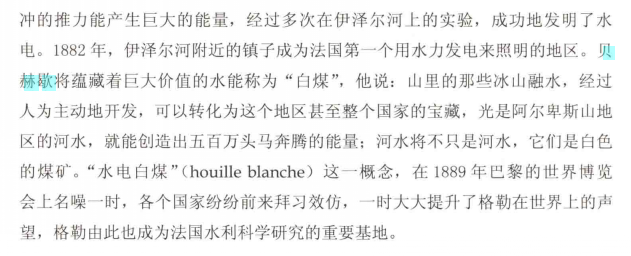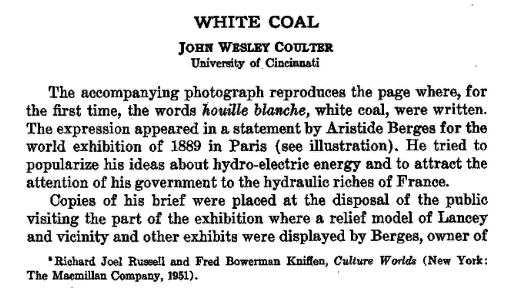博文
将水力比作“白煤”的创造者、全球水电先驱、法国Aristide Berges先生
||
将水力比作“白煤”的创造者、全球水电先驱、法国Aristide Berges先生
——把水力正式比作白煤的看来是Aristide Berges,时间约是1889年或更早
——比喻中的白煤,在Aristide Berges心中,大体是阿尔卑斯山的冰川径流
陈昌春
将河流中的水力资源被比作“白煤”(法语:La houille blanche;英语:或Water coal;德语:Weiße Kohle)的文献,中外文都很常见。但是,这种比喻的最早出处是什么呢?中文文献中,似乎罕见介绍。
水力被称“白煤”的的原因,《近现代辞源》引用的文献说是像雪。有称,人们常把水力比做“白煤”,这是因为水的颜色近似白色。

《拿破仑之路》(傅杰妮著,2014)一书介绍:“话说伊泽尔河是格勒之源,却也是格勒之痛。由于它路经陡峭山势,养成火辣的脾性,经常犯淹涝之灾。这股看似使不完的蛮力,却在19世纪给工程师贝赫歇(Aristide Berges)带来了灵感。唐代的李沛曾写道禹凿山川地,因通四水流;入河无昼夜,归海有谦柔;顺物宜投石,逢时可载舟顺自然之大力,找到合适的化解方式,逢时便可载上化蛮顽为喜善的前进之舟。经过多年研究,贝赫歇发现水格勒诺... ”




JOHN WESLEY COULTER先生在1953年发表于《Journal of Geography》一文中指出,该词出现于1889年的世界博览会。
英文网页有称,The term white coal was used for Hydroelectricity, particularly in Europe, because of its capability to produce more energy than any other source except coal. The term was coined by a French Engineer Aristide Berges.
英语词典网站https://www.merriam-webster.com/dictionary/white%20coal词条认为,该词最早出现于1875年。不过,并没有提供用例。

英语词典网站https://www.collinsdictionary.com/dictionary/english/white-coal认为,该词大体出现于1980-1885年间(This word is first recorded in the period 1880–85)。
有词语出处网站提到, White water "river rapids" is recorded from 1580s.(https://www.etymonline.com/word/coal)。
英文网络文章《Aristide Bergès: Water as “White Coal” at Expo 1889 Paris》介绍:“1889年巴黎世博会,因将世界引入埃菲尔铁塔而被铭记。然而,它也是另一个重要的首次亮相的地方。法国有远见的工程师Aristide Bergès展示了水力发电,这一概念被称为 "Houille Blanche "或 "白煤",席卷了欧洲和世界。19世纪中期,工业革命使煤炭成为主要的能源来源,因此也是一种珍贵的商品。因此,在世博会上,Bergès的展品向参观者介绍了一种替代能源,他将其称为 "白煤",以吸引参观者的注意,并强调山水的能源潜力,这一点在煤炭方面被忽视了。 他的展览展示了一个附有牌匾的涡轮机,其中包括一个以 "白煤开发 "为开头的长长的题词。这个概念在1882年已经在Bergès的第一个造纸厂靠近Lancey湖(位于法国伊泽尔省)的地方进行了测试,在那里他利用阿尔卑斯山的水,用笔架技术为机器供电。这涉及到将下降的水流引向连接到工厂内一组涡轮机的金属管道。然而,湖水的不规则流动阻碍了Bergès的大规模纸张生产计划。”
《L'Exposition Internationale de la Houille Blanche et du Tourisme》一文指出,阿里斯蒂德·贝格斯先生是“白煤”这个美丽短语的作者。在1889年世博会上发表的一封信中,他说:“在‘高处’的水似乎不再是‘水,而是‘从土壤中自动吸出的黑煤’,然后‘白煤’这个名字自然出现在脑海中,用来‘洗礼这些财富’。“从‘白煤’的角度来看,‘在这一切中,没有白煤’,这显然只是一个比喻,但我想用‘这个词来激发想象力,生动地指出’冰川和山脉可以作为‘驱动力,对地区和国家来说,是’像深海煤矿一样宝贵的财富’。”
大体看下来,最早把水力比作白煤的看来是Aristide Berges(阿里斯蒂德.伯格斯),时间可能是1875年或稍迟。附1对使用“白煤”比喻水力的经过进行了详细的介绍。从颜色看,白色可指指急流或飞流直下的瀑布之白色泡沫与浪花。中文文献中把“白煤”视作具体的“白之雪”或含糊的“白之水”,看来各有道理。
Marc Landry在《On Water: Perceptions, Politics, Perils》一书之“Water as White Coal”中认为,白色是用于形容阿尔卑斯山的冰川径流。他写道:“The term Bergès coined also proved wildly successful. Though he had used it to describe the power potential of glacial runoff, white coal quickly became one of the most popular metaphors to describe hydroelectricity across the globe. .......Though the term white coal eventually came to mean hydroelectricity, Bergès had something different in mind. For him, the color white referred specifically to the eternal ice of Alpine glaciers, whose runoff he had managed to harness for industrial purposes. He had first done this at his own paper mill in the Isère Valley in the late 1860s”.
Aristide Bergès: Water as “White Coal” at Expo 1889 Paris
jeudi 23 février 2017
Expo 1889 Paris is remembered for introducing the world to the Eiffel Tower. However, it was also the site of another important debut: French visionary engineer Aristide Bergès’ demonstration of hydroelectricity, a concept known as “Houille Blanche” or “White Coal”, that swept through Europe and the world.
In the mid 19th century, the industrial revolution made coal the major source of energy and thus, a precious commodity. So when at the Expo, Bergès’ exhibit informed visitors about an alternate energy source, he called it “Houille Blanche”, to draw attention from visitors and to highlight the energy potential of water from the mountains, which had been ignored in favour of coal.
His display showed a turbine with a plaque attached that included a long inscription starting with ‘The Exploitation of White Coal’.
This concept had been tested in 1882 at Bergès’ first paper mill close to lake Lancey (in the French department of Isère), where he used Alpine water to power the machines using the penstock technique. This involved diverting descending torrents into metal pipes connected to a set of turbines in the factory. However, the lake’s irregular flow hindered Bergès’ plan for mass paper production.
The increased needs for energy to power the defibering machines were satisfied by harnessing power from 200- and then 500-meter high-head falls, when Bergès discovered that the farther the water falls, the more power it generates. Then driven by the motto “technology should serve humanity”, he attached a Gramme Dynamo to the turbines and discovered that it produced electricity; which he used to power his mill; and eventually the entire community of the Grésivaudan valley.
Aristide Bergès’ ceaseless contributions to long-lasting energy solutions and his legacy of using the power of water from the mountains ushered in the hydropower revolution at the end of the 19th century. His modernisation and industrialisation of hydro-mechanical techniques gave the Alps an advantage in terms of industrial growth and paved the way for solutions to current challenges in energy, which will be discussed in detail at Expo 2017 Astana, themed “Future Energy”.
https://wap.sciencenet.cn/blog-350729-1367879.html
上一篇:参加第一次三峡水力勘测、选址并设想丹江口水库坝址(南水北调中线起点)的史笃培先生全名
下一篇:中国水利工程学会1931年4月22日成立关于“议决会章”或“通过章程”的不同说法